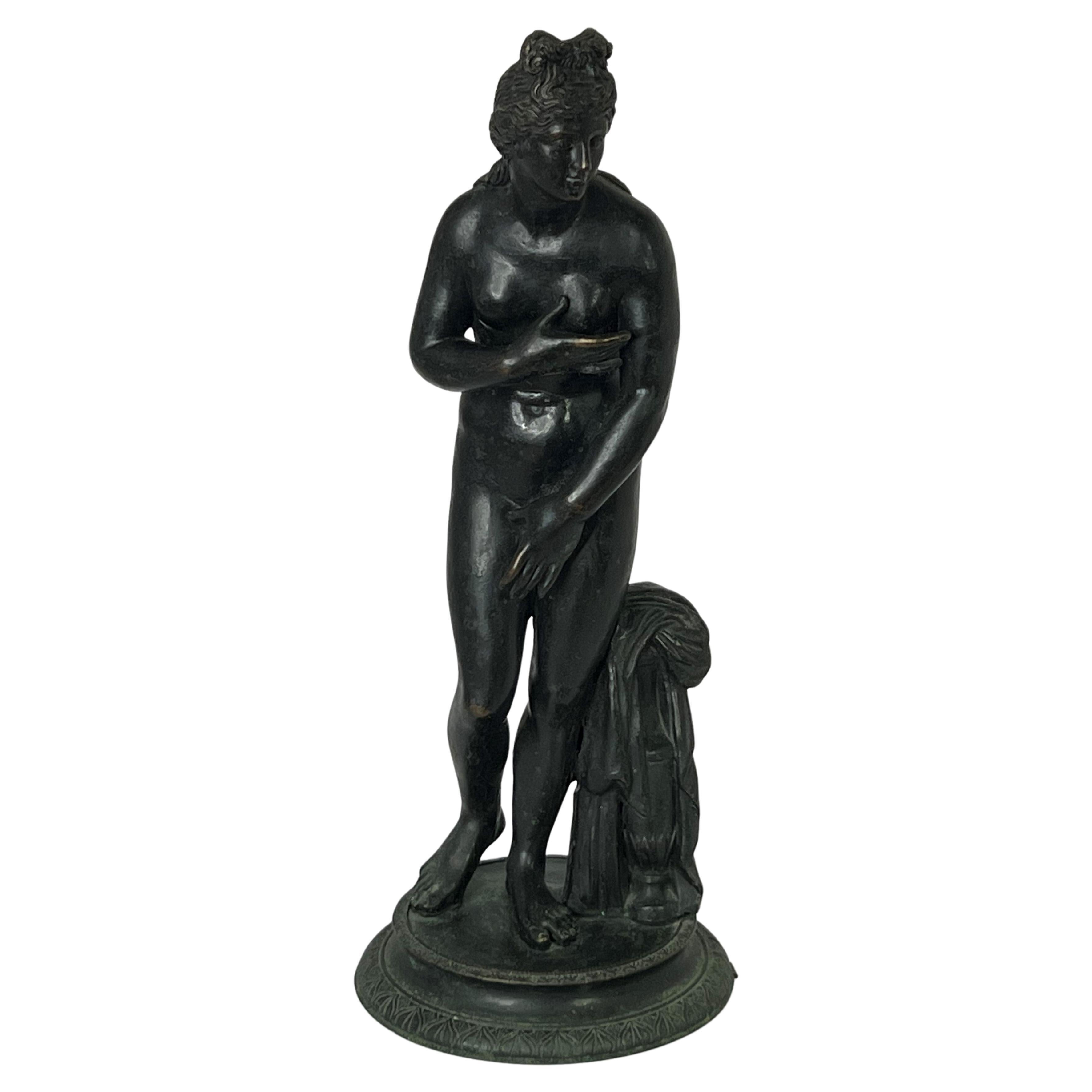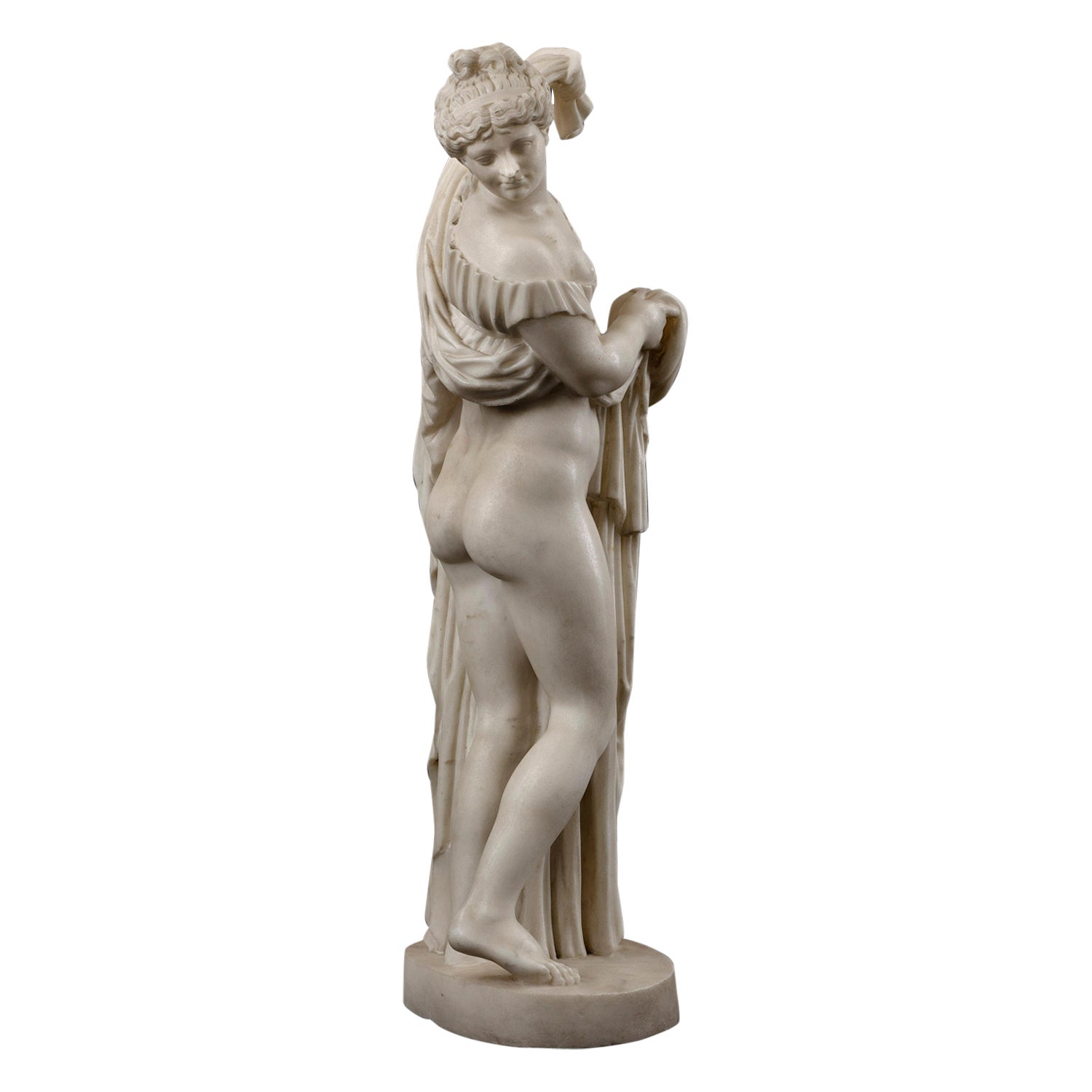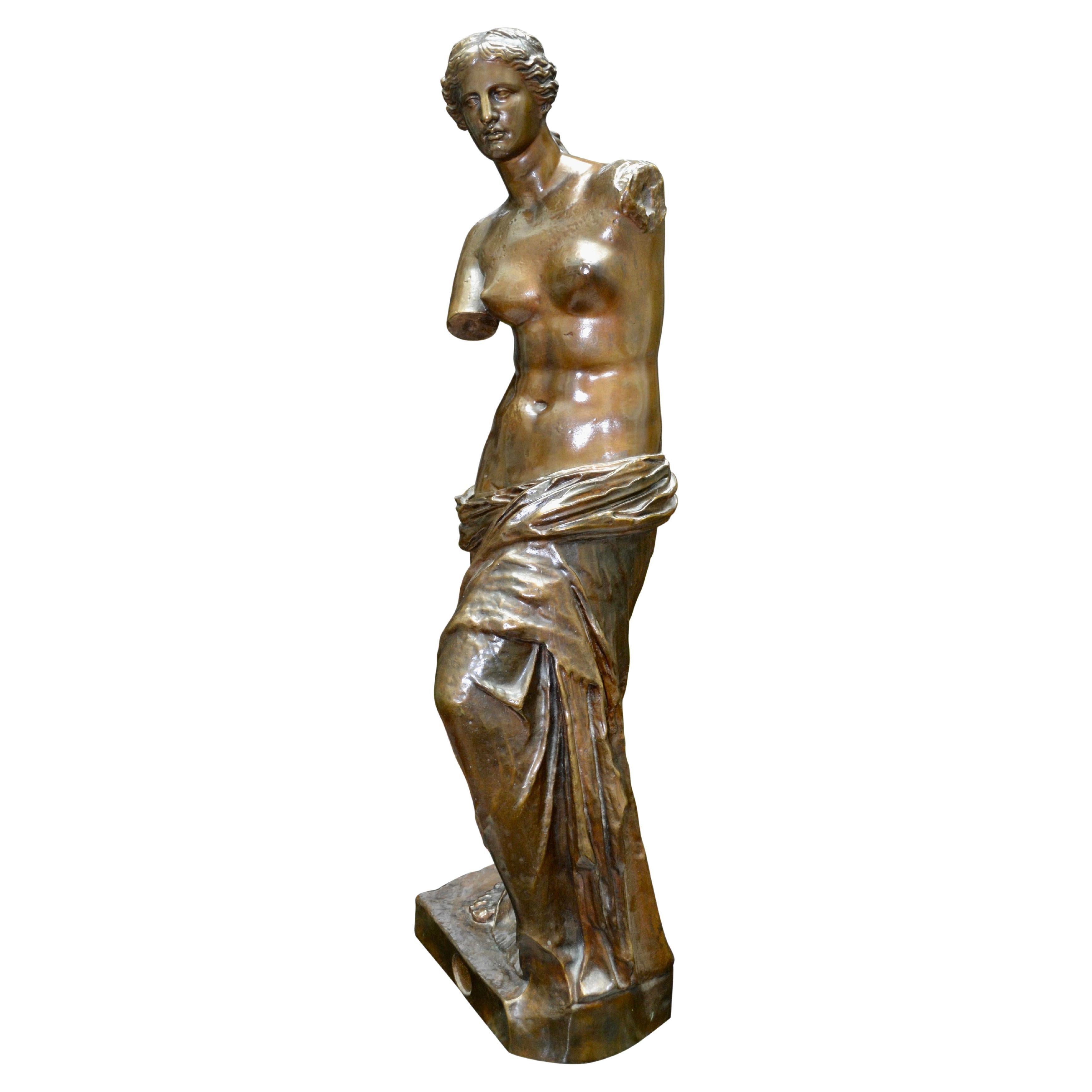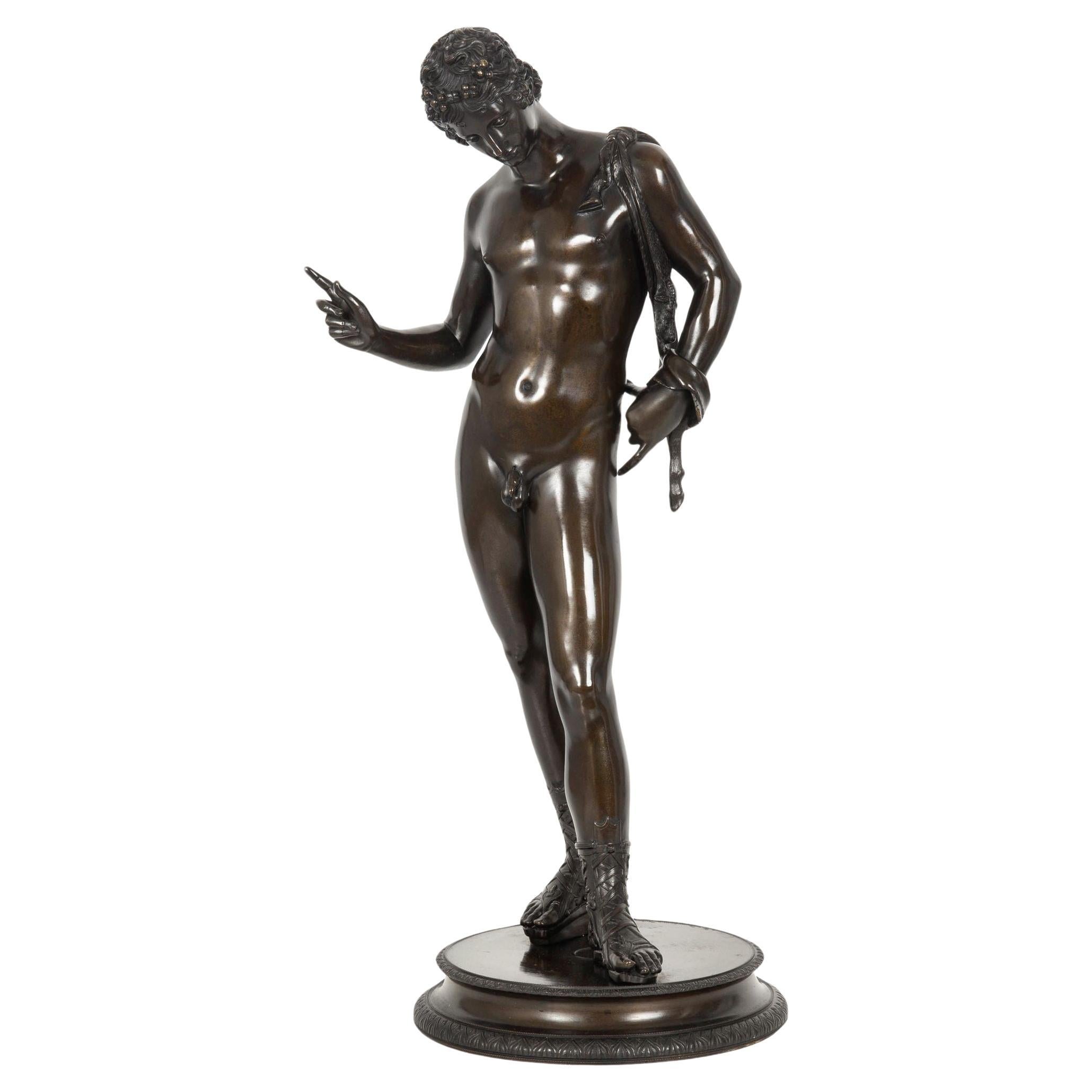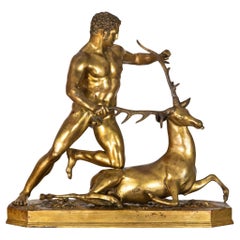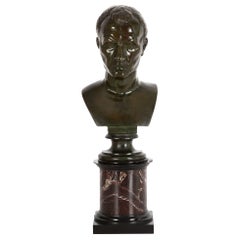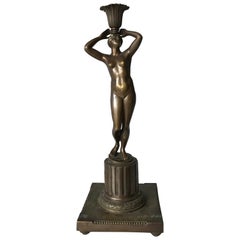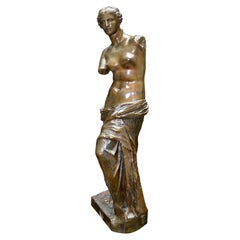Items Similar to 19th Century Grand Tour Bronze Sculpture “Callipygian Venus” of Antiquity
Want more images or videos?
Request additional images or videos from the seller
1 of 21
19th Century Grand Tour Bronze Sculpture “Callipygian Venus” of Antiquity
About the Item
GRAND TOUR MODEL AFTER ANTIQUITY
Naples, Italy (19th Century)
"The Callipygian Venus"
Sand-cast and patinated bronze signed foundry mark in the base "Fonderia Artistica Sommer Napoli" (active by 1885-1916) cast late 19th century
Item # 402KRG29Z
A beautifully cast Grand Tour reduction of the Callipygian Venus after the life-size statue of antiquity, the sculpture was executed by the boutique foundry established by Giorgio Sommer (German/Italian, 1834-1914) for the casting of sculpture in bronze and later the carving of sculpture in marble. Giorgio Sommer was a German photographer who spent most of his career in Italy, moving to Naples in 1857 where he first established his photography business. At some point thereafter he opened the foundry, which was rather successful, likely due to the very fine quality of output the firm produced. While most records show the foundry opened in 1885, sources suggest they were producing sculpture early in the 1870s before exhibiting in 1885. Thereafter they produced illustrated cataloges of their sculpture for marketing and distribution. He died in 1914 and the foundry survived him only two years before closing its doors in 1916.
The present example is a richly detailed model with extensive carving and articulation of the underlying model; note the rich stylus work in Venus's hair, the handiwork apparent in the repeating motif around the base and the raised signature of the foundry, which is captured directly from the mold and not simply cold-tooled onto the base. The surface throughout is characterized by perfection: smooth and exquisitely finished garments and skin all finished in a medium-brown translucent patina.
The model depicts the Callipygian Venus, also known as the Venus Kallipygos or the Aphrodite Kallipygos. The term "Callipygian" is derived from the Greek words "kallos" meaning beautiful, and "pyge" meaning buttocks.
The original is an ancient Roman marble statue, itself a copy of an earlier Greek statue from the Hellenistic era. The sculpture depicts Venus (or Aphrodite in Greek mythology) looking back and lifting her drapery to reveal her lower back and buttocks. This subject was popular among tourists on the Grand Tour during the 18th and 19th centuries. Travelers would commission or purchase such artworks as mementos that reflected the cultural heritage they encountered on their journeys throughout Europe, especially in Italy.
Such sculptures were admired not only for their aesthetic appeal but also for their cultural and historical significance, embodying the Neoclassical appreciation for the art and mythology of antiquity that was prevalent during the Grand Tour period.
Literature:
An excellent discussion on Fonderia Sommer can be found at Art UK rooted in original source material. Click here to read more on the foundry and Giorgio Sommer's photography.
Measurements: 25 1/2" H x 9 7/8" base diameter
Condition Report:
Trace wear to patina throughout; ever so slight inward curve to the base, perhaps being cast slightly too thin to properly support the weight of Venus in the center. Carefully cleaned and sealed in conservator's grade wax.
About silla antiques & art
Established in 2009, we have available in our 9000 square foot brick-and-mortar gallery an ever-changing selection of carefully curated and catalogued furniture, decorative arts, paintings, sculpture and estate jewelry. Our company has long specialized in sculpture circa 1860 through 1930 and as such the gallery always has a very large collection of exceptional European and American sculpture available on display.
The gallery is located at 117 W Burd Street in Shippensburg, Pennsylvania and is open by appointment only. We welcome your visit and would love to meet with you at the shop. For clients located outside of the area, we are always available to discuss items by video conferencing or by phone.
- Dimensions:Height: 25.5 in (64.77 cm)Width: 9.88 in (25.1 cm)Depth: 9.88 in (25.1 cm)
- Style:Grand Tour (Of the Period)
- Materials and Techniques:
- Place of Origin:
- Period:
- Date of Manufacture:Unknown
- Condition:Trace wear to patina throughout; ever so slight inward curve to the base, perhaps being cast slightly too thin to properly support the weight of Venus in the center. Carefully cleaned and sealed in conservator's grade wax.
- Seller Location:Shippensburg, PA
- Reference Number:Seller: 402KRG29Z1stDibs: LU1059039184512
About the Seller
4.9
Recognized Seller
These prestigious sellers are industry leaders and represent the highest echelon for item quality and design.
Platinum Seller
These expertly vetted sellers are 1stDibs' most experienced sellers and are rated highest by our customers.
Established in 2009
1stDibs seller since 2014
476 sales on 1stDibs
Typical response time: 1 hour
- ShippingRetrieving quote...Ships From: Shippensburg, PA
- Return PolicyA return for this item may be initiated within 14 days of delivery.
Authenticity Guarantee
In the unlikely event there’s an issue with an item’s authenticity, contact us within 1 year for a full refund. DetailsMoney-Back Guarantee
If your item is not as described, is damaged in transit, or does not arrive, contact us within 7 days for a full refund. Details24-Hour Cancellation
You have a 24-hour grace period in which to reconsider your purchase, with no questions asked.Vetted Professional Sellers
Our world-class sellers must adhere to strict standards for service and quality, maintaining the integrity of our listings.Price-Match Guarantee
If you find that a seller listed the same item for a lower price elsewhere, we’ll match it.Trusted Global Delivery
Our best-in-class carrier network provides specialized shipping options worldwide, including custom delivery.More From This Seller
View All19th Century Italian Grand Tour Antique Bronze Sculpture of “Narcissus”
Located in Shippensburg, PA
RAND TOUR
Italy, late 19th century
"Narcissus"
Patinated bronze cast by the Michele Amodio foundry of Naples, signed to base cast third quarter of 19th century
Item # 406SKN07W
...
Category
Antique 19th Century Italian Grand Tour Figurative Sculptures
Materials
Bronze
Large Italian 19th Century Grand Tour Bronze Sculpture “Hercules & Cerynitis”
Located in Shippensburg, PA
GRAND TOUR
Italy, 19th century
Hercules Subduing the Stag Cerynitis
Sand-cast and patinated bronze signed to the base "Fond = Amodio Napoli" cast circa late 19th to early 20th ce...
Category
Antique 19th Century Italian Grand Tour Figurative Sculptures
Materials
Bronze, Copper
Italian Grand Tour Antique Bronze Sculpture, Bust of Julius Caesar
Located in Shippensburg, PA
GRAND TOUR
Italian, 19th century
Bust of Julius Caesar
Patinated and pigmented sand-cast bronze over Violet Breche marble socle unsigned
Item # 212WHZ09P
A finely cast and beau...
Category
Antique 19th Century Italian Grand Tour Busts
Materials
Marble, Bronze
Grand Tour Barbedienne French Bronze Sculpture “Mercury” after Giambologna
By Giambologna
Located in Shippensburg, PA
AFTER GIAMBOLOGNA (Jean de Bologne)
Flemish, 1529-1608
Mercury Riding on the Wind
Patinated bronze engraved to base "F. BARBEDIENNE. FONDEUR." and sealed with A. Collas reduction ...
Category
Antique 19th Century French Grand Tour Figurative Sculptures
Materials
Marble, Bronze
Pair of Grand Tour Bronze Busts, “Homer” & “Pseudo-Seneca”, circa 1880
By Chiurazzi fondata
Located in Shippensburg, PA
GRAND TOUR
Italian School
Pair of Busts, "Homer" & "Pseudo-Seneca", after Antiquity
Patinated bronze mounted on solid marble plinths cast by Chiurazzi, Naples circa 1880 each sealed with foundry cachet on shoulder
Item # 304KUV24Y
A rare and exciting pair of Grand Tour busts after Antiquity, each is executed in bronze and finished in a Herculaneum black patina with hints of verde in the underlying surface by the foundry of J. Chiurazzi of Naples. Foundry seals are located on their shoulders verso.
The first is a fine cast of Homer after the marble bust of Antiquity formerly in the Farnese collection and currently in the permanent collection of the National Archaeological Museum of Naples. It depicts the aged Greek poet and author of the Illiad and the Odyssey as a bearded man dressed in a tunic with a ribbon holding back his hair while concerned wrinkles line his forehead. His eyes are empty and devoid of anything, the absence alluding to his blindness while the sheer intensity of his spirit overwhelms the viewer. His simple garment are a reminder of his poverty.
The second bust known as "Pseudo Seneca" is cast after the original bust of antiquity found in 1754 at Herculaneum in the Villa of the Papyri, the home of Lucius Calpurnius Piso Caesoninus, father-in-law of Julius Caesar. The estate was buried in the eruption of Mount Vesuvius. The bust had been thought to be an image of Lucius Annaeus Seneca - Seneca the Younger - the famous Stoic philosopher and fabulously wealthy advisor to Nero. However, after a titled bust of Seneca...
Category
Antique 19th Century Italian Grand Tour Busts
Materials
Marble, Bronze
French Bronze Sculpture Antique Bust of Greek Warrior, late 19th century
Located in Shippensburg, PA
FRENCH SCHOOL
4th qtr, 19th century
Bust of Greek Warrior
Patinated bronze unsigned cast circa late 19th century
Item # 304KEX30P
A fine ca...
Category
Antique 19th Century French Romantic Busts
Materials
Bronze
You May Also Like
Capitoline Venus Grand Tour Mid 19th century bronze
By Praxiteles 1
Located in Mobile, AL
This grand tour bronze sculpture depicts the version of Venus so important to the history of art and literature in the U.S. that the original was temporarily loaned to the National Gallery of Art from the Capital Museums in Rome in 2011. Mark Twain visited Rome and upon his return home in 1867 he published "The Capitoline Venus" and he described the work as the “most illustrious work of ancient art the world can boast of". (with credit to the National Gallery of Art catalog...
Category
Antique Mid-19th Century European Grand Tour Figurative Sculptures
Materials
Bronze
Late 19th Century Grand Tour Italian Bronze Sculpture of Nude Venus Candlestick
Located in Lisse, NL
Elegant and highly stylish candlestick or table lamp.
This handcrafted and heavy quality, bronze candle stick or table lamp from the 1890-1910 era is in very good condition. This ro...
Category
Antique Late 19th Century Italian Grand Tour Table Lamps
Materials
Bronze
Callipygian Venus - Italian, 19th Century
Located in Bruxelles, BE
Callipygian Venus
19th Century
Italian (Naples or Rome)
White marble
After the Antique: Naples Archaeological Museum (IT)
Roman version of a Hellenistic 3rd Century B.C. model
Height: 62 cm
Width: 22 cm
H 24 1/2 x W 8 2/3 inch
The Callipygian Venus, also known as the Aphrodite Kallipygos or the Callipygian Venus, all literally meaning “Venus of the beautiful buttocks”, is an Ancient Roman marble statue...
Category
Antique Mid-18th Century Italian Neoclassical Figurative Sculptures
Materials
Marble
19th Century Grand Tour Bronze Statue of Venus of Milo
Located in Vancouver, British Columbia
A very fine Grand Tour bronze study of the famous Venus de Milo with excellent rich brown patina and good hand finished surface detail. The casting is unusual in that it does not pretend to hide the many imperfections on the original.
It is signed on the base with "Reduction Mechanique Ronald Collas, and for the foundry F.Barbidienne Fondeur. Foundry stamp on the base
Considered by any to be the most beautiful Hellenistic statue to survive fro antiquity, the Venus of Milos...
Category
Antique Late 19th Century French Neoclassical Figurative Sculptures
Materials
Bronze
$5,625 Sale Price
25% Off
19th Century French Grand Tour Venus de Milo Bronze
Located in Chicago, IL
A striking and alluring 19th century French Grand Tour cast bronze sculpture depicting the Ancient Greek goddess Aphrodite, and named for her Roman counterpart, Venus. The original was discovered in 1820 on the island of Milos, hence the name Venus de Milo, and is now housed in the Louvre in Paris.
The Grand Tour became a right-of-passage during the 17th-19th centuries for the upper class serving to educate men and boys in classical art and architecture found throughout the European continent. Bronzes of this scale were brought back to England as souvenirs. This piece is marked "FRANCE" on the backside, and "Musée de Louvre...
Category
Antique 19th Century French Classical Greek Figurative Sculptures
Materials
Bronze
19th Century Grand Tour Bronze Figure of Diana
Located in Stockton, NJ
A finely cast 19th century Grand Tour figure of a Diana.
Category
Antique 1870s Grand Tour Figurative Sculptures
Materials
Bronze
Recently Viewed
View AllMore Ways To Browse
Antiquity Jewelry
Antique Grand Doors
Ancient Greek Antiquities
Antique Grand Tour Painting
Neoclassical Artwork
Venus Jewelry
Bronze Mortar
Ancient Brick
Roman Historical Paintings
Antique Jewelry Molds
Antique Painting Tools
Grand Period Jewelry
18th Century American Painting
Model 9000
19th Century Italian Marble Carvings
Grand Tour Jewellery
Antique Bronze Mortar
Antique Bronze Mortars
